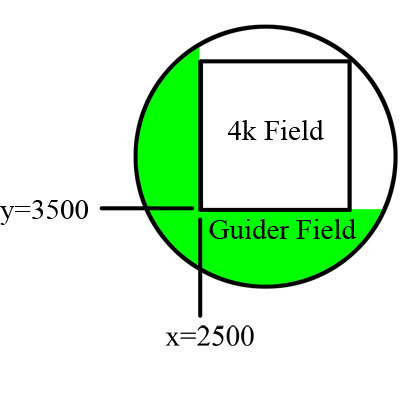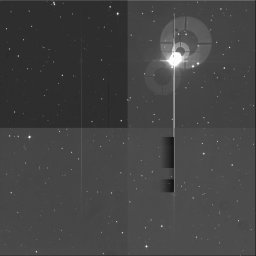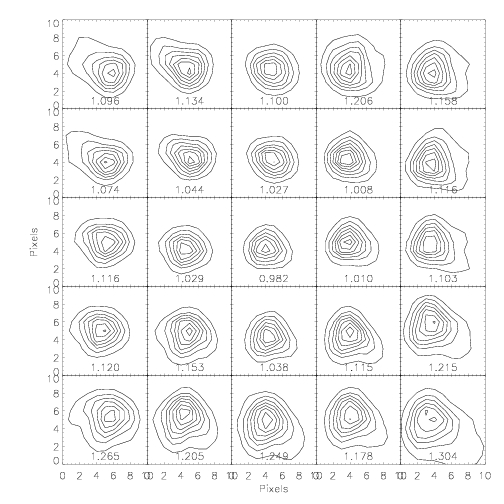MDM Blue 4Kx4K CCDContents: |
Summary
The OSU Blue 4K CCD is a wide field CCD imager designed for the 1.3-m telescope as a facility instrument for direct imaging. The detector is a Silicon Technology Associates STA-0500 CCD with 4064x4064 15-micron pixels. This delivers a 21.3-arcminute square field of view on the MDM 1.3m telescope. The CCD is read out using four amplifiers, it can be binned up to 8x8 pixels, and readout in a number pre-defined centered subframe regions of interest. It is mounted to the "Buckeye" 12-position filter wheel on the MIS unit. this filter wheel can hold up to twelve (12) 4-inch square filters and is currently equipped with Johnson UBVRI filters and SDSS ugriz filters.
The four readout amplifiers have a gain of 2.2-2.4 electrons per ADU and a read noise of 5 electrons (rms). It has superb blue sensitivity out to the U band, and because it is a thinned, backside-illuminated CCD, it fringes in the far red (I, i, and z).
MDM4K Pictures: On 1.3-m | Horsehead | M15 | M33 | M42 | M77 | Moon | NGC3628 | M51
CCD Characteristics & Parameters
- Dimensions: 4064 × 4064; 15µm square pixels
- Detector Characterization Report (UA Imaging Technology Lab)
- FOV: 21.3'x21.3' (0.315" per unbinned pixel)
- Orientation: North is right, East is down. To get the standard (N up E left) view, flip x and rotate 270.
- Gain: 2.2-2.4 electrons per ADU
- Read noise: 5 electrons
- Linearity: Linear to 45000 ADU (65000 ADU in any binned mode)
- Full well 107K e-
- ITL Measured quantum efficiency curve and QE data (ASCII text file).
- Operating temperature: -124 C
- Dewar hold time: ~19 hours. Some nitrogen can spill out during slews; the dewar should be filled before and after each night of observing.
- Thinned and packaged by the University of Arizona Imaging Technology Laboratory
- Mounted and interfaced by OSU
- Binning: 1x1, 2x2, 4x4, and 8x8. (pr>ccdbin bin=n command)
- Overscan: Both the x and y overscan are user selectable, in
*unbinned* pixels (pr> overscan [xover=nx] [yover=ny])
- Overscan size must divisible by the binning factor (2,4,8)
- Subframe Region Of Interest (ROI): Pre-selected ROIs are avaliable. You
can choose between 4Kx4K (full frame, 134 sec read), 2Kx2K (40 sec
read), 1Kx1K (15 sec read), or 512x512 (10 sec read) centered on the
chip. You can use ROI on a binned image, but note that the region
size is in unbinned pixels. To set the ROI, in prospero, type
- call roi4k
- call roi2k
- call roi1k
- call roi512
Readout Time
The readout time estimates include of the overhead to prep the chip, query the telescope, and update the status of the instruments, in addition to the time it actually takes to read the detector. The time it takes to read the chip scales with the number of pixels, and the amount of overhead depends on the image-taking mode. See the table on the right for read times, in seconds. The three readout modes and their consequences are explained below. GO n:
MGO n: Does GO for first image, then on subsequent images same as GO except
TGO n: Same as MGO except during subsequent images
|
*Applies only to images after the first in a sequence. The first image in every sequence will take the same time a "go" takes for a given binning. All times are accurate to 1/8 of a second. |
Flat Fields
Cross-Talk
When stars are strongly saturated on one quadrant, there is significant crosstalk into pixels in the other three quadrants. The effect is strongest in side-by-side quadrants, and weaker in top-to-bottom quadrants, consistent with the expected crosstalk signal pathway through these devices.
A particularly good example of cross-talk is shown above, with a purposely badly saturated stars on the upper right quadrant. Click on the image to view a higher resolution version. Faint ghosts of the saturated star and the bleed streaks are visible on the other three quadrants.
An algorithm for removing the cross-talk artifacts is included in the proc4k IDL reduction pipeline.
Guider
| Because of the large field of view of the MDM4K, the guider space is limited and it is easy to vignette the science field with the guider probe. You cannot exceed x=2500, y=3500 at the same time without vignetting the field. The cartoon to the right is not to scale. |  |
Focus
- set the first focus position
- pr> focus n first
- adjust focus
- pr> focus n
- adjust focus
- ...
- pr> focus n
- set focus to last position
- pr> focus last
- pr> focus n first
Shutter
In order to ignore the shutter correction, a minimum exposure of 10 seconds is recommended. For a one second exposure, the central area of the chip is ~5% high. A 10 second exposure has a ~1% error in the center of the field and a 60 second exposure has a ~0.1% error. |
 |
Humidity
Because of the large, cold dewar window, the MDM4K is particularly susceptible to condensation on the dewar window (see figure on the right). We therefore revise the safe observing limit to 80% humidity for the MDM4K. A dry nitrogen line will be installed to recover from this. If this happens before a line is installed, run the nitrogen line (by the pier) into the filter wheel, turn it on, and take a 15 minute exposure (to open the shutter and vent it out). Repeat if necessary. |
 |
Performance and Throughput
- TBD...
Image Quality
Known Problems
- Several timing bugs arise with 16x16 binning. It is recommended for the time being not to use this mode.
- Occasionally during a sequence, caliban writes both the given filename *and* a unique name, and issues the following warning
- [CB>WARNING FITS file '/path/to/file/filename.fits' already exists, writing as '/path/to/file/uniquename.fits' instead]
- Note: if you get this warning and you have accidentally specified a filename/extension that already exists, do not ignore it.
- There is a gap in the middle in the blow up of the center region in the readout monitor. This is purely an aesthetic problem on the readout monitor.
Reductions
An IDL program to do the basic reductions (crosstalk, overscan, flat, [fringe,] wcs) of the night's data can be found here. To run it, you'll need the IDL astronomy library in your path (available for download here) then simply type
IDL> proc4k, '*.fits'
where '*.fits' is a wildcard to select all the images you want to reduce, including appropriate calibration images. The steps are outlined below. Further details and more explicit operating directions are in the program file. Everything but the coordinate solution takes ~30 minutes for a night. The coordinate solution, depending on how accurate the pointing was, can take several hours.
- Subtracts the cross talk from every image, sets pixels affected by saturated pixels to the saturation level (added by Calen Henderson, OSU)
- filename.fits -> filename.x.fits
- Subtract the median value of the overscan from each row for each image
- Flips every image to be oriented N up, E left.
- Adds header keywords EPOCH=2000 and SECPIX=0.315*bin
- filename.x.fits -> filename.xo.fits
- Creates a normalized master flat for each filter and bin by median combining all of the mode-scaled flat images. Outputs masterflat[bin][filter].fits. For example, for a 2x2 binned I flat, the master flat will be called masterflat2I.fits.
- Divides every object frame by its corresponding flat
- filename.xo.fits -> filename.xof.fits
- For each I-band image, it subtracts a pre-made fringe image. If a fringe image has not already been created and given the name fringe[bin].fits, one from September 2007 can be downloaded from this site by calling the program like this:
- IDL> proc4k, '*.fits', /forcefringe
- adds header keyword FRINGECOR with the value equal to the scale used.
- filename.xof.fits->filename.xoff.fits
- The stock fringe image is probably no longer valid, use with caution. Please email me if you have problems with it or if you have an updated fringe image.
- Optionally determines the coordinate solution of the image
- Requires SExtractor, WCSTools, and the files daofind.sex, daofind.param, default.conv, and default.nnw.
- Requires the path to the USNOb catalog specified by the environment variable UB1_PATH (at OSU, add "setenv UB1_PATH /data/catalogs/usnob" to your .tcshrc file).
- filename.xof.fits -> filename.xofw.fits (or filename.xoff.fits -> filename.xoffw.fits for fringe corrected images)
- Takes a few seconds or up to 15 minutes per image, depending on how accurate the original coordinates are.
- Outputs a DS9 region file to check the solution. The region file should circle all of the bright stars in the image.
Note: Biases are never used. The overscan does a much better job and what little large scale structure there is isn't stable enough to reliably subtract.
If you have questions about, have additions to, or find bugs in this program, please contact Jason Eastman ( ) .

